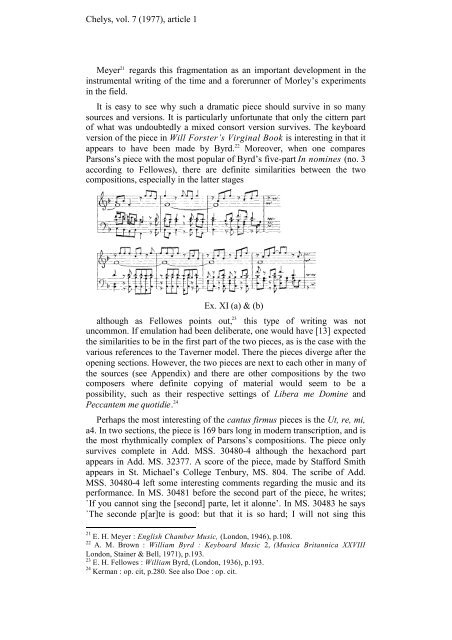download.pdf - 6.3Mb - Viola da Gamba Society
download.pdf - 6.3Mb - Viola da Gamba Society
download.pdf - 6.3Mb - Viola da Gamba Society
You also want an ePaper? Increase the reach of your titles
YUMPU automatically turns print PDFs into web optimized ePapers that Google loves.
Chelys, vol. 7 (1977), article 1<br />
Meyer 21 regards this fragmentation as an important development in the<br />
instrumental writing of the time and a forerunner of Morley’s experiments<br />
in the field.<br />
It is easy to see why such a dramatic piece should survive in so many<br />
sources and versions. It is particularly unfortunate that only the cittern part<br />
of what was undoubtedly a mixed consort version survives. The keyboard<br />
version of the piece in Will Forster’s Virginal Book is interesting in that it<br />
appears to have been made by Byrd. 22 Moreover, when one compares<br />
Parsons’s piece with the most popular of Byrd’s five-part In nomines (no. 3<br />
according to Fellowes), there are definite similarities between the two<br />
compositions, especially in the latter stages<br />
Ex. XI (a) & (b)<br />
although as Fellowes points out, 23 this type of writing was not<br />
uncommon. If emulation had been deliberate, one would have [13] expected<br />
the similarities to be in the first part of the two pieces, as is the case with the<br />
various references to the Taverner model. There the pieces diverge after the<br />
opening sections. However, the two pieces are next to each other in many of<br />
the sources (see Appendix) and there are other compositions by the two<br />
composers where definite copying of material would seem to be a<br />
possibility, such as their respective settings of Libera me Domine and<br />
Peccantem me quotidie. 24<br />
Perhaps the most interesting of the cantus firmus pieces is the Ut, re, mi,<br />
a4. In two sections, the piece is 169 bars long in modern transcription, and is<br />
the most rhythmically complex of Parsons’s compositions. The piece only<br />
survives complete in Add. MSS. 30480-4 although the hexachord part<br />
appears in Add. MS. 32377. A score of the piece, made by Stafford Smith<br />
appears in St. Michael’s College Tenbury, MS. 804. The scribe of Add.<br />
MSS. 30480-4 left some interesting comments regarding the music and its<br />
performance. In MS. 30481 before the second part of the piece, he writes;<br />
`If you cannot sing the [second] parte, let it alonne’. In MS. 30483 he says<br />
`The seconde p[ar]te is good: but that it is so hard; I will not sing this<br />
21 E. H. Meyer : English Chamber Music, (London, 1946), p.108.<br />
22 A. M. Brown : William Byrd : Keyboard Music 2, (Musica Britannica XXVIII<br />
London, Stainer & Bell, 1971), p.193.<br />
23 E. H. Fellowes : William Byrd, (London, 1936), p.193.<br />
24 Kerman : op. cit, p.280. See also Doe : op. cit.
















